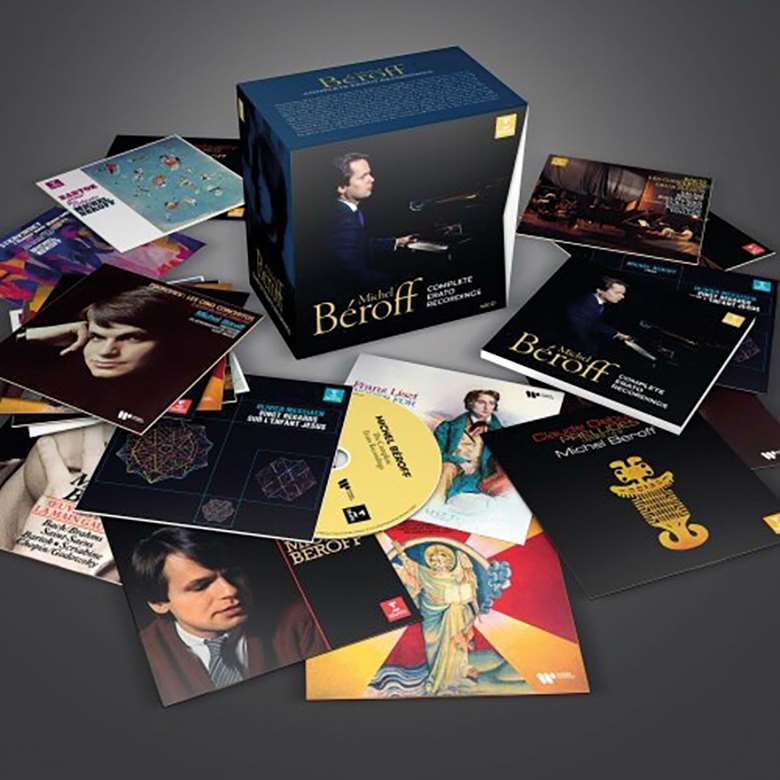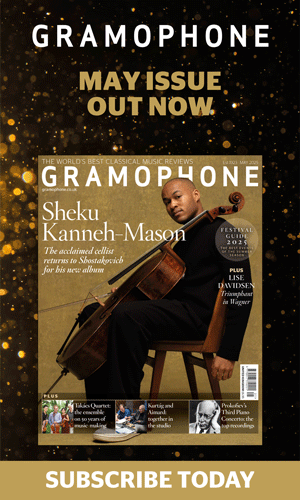Michel Béroff at 75: Erato's monumental box-set celebrates a brilliant and versatile pianist
Jed Distler
Thursday, April 17, 2025
Jed Distler revisits the Frenchman’s EMI and Erato recordings in a new 42-disc set

Born in 1950, Michel Béroff began recording while still a prodigious teenager. The pianist amassed a sizeable discography for EMI Classics and Erato between 1968 and 1985, until the onset of focal dystonia curtailed his two-handed keyboard activity for several years. By 1993 he had recovered and was able to participate in two final projects for the label: Bach’s Concerto in G minor and a programme of French works for piano duo with his longtime friend and colleague Jean-Philippe Collard. A number of Béroff’s EMI discs have gained frequent reissue, while others have slipped through the proverbial cracks. Erato now brings its Béroff holdings all together in a 42‑disc box‑set. The discs are packaged in original jacket facsimiles and arranged in more or less alphabetical order by composer, with the final disc featuring newly released material.
Rehearing Bach’s complete multi-keyboard concertos conducted by Jean-Pierre Wallez, I was impressed anew by the crystalline clarity of texture and timbral distinction between the pianos, as well as the subtle dynamic scaling and alluringly elegant trills. The slow movement of the C minor Double Concerto, BWV1062, is a case in point. ‘I do not find the playing excessively inflated: on the contrary, the expressiveness is pitched at a level which seems to me right for the sonorities’, wrote my late colleague Stephen Plaistow in his original review (6/84). But I can’t agree with his ‘nondescript’ characterisation of the conductor’s orchestral framework, as the shapely unanimity of the unison passages in the three-piano D minor Concerto, BWV1063, bears out.
Béroff’s head, heart and fingers merge most tellingly in 20th-century music
If anything, Béroff’s ambidextrous aplomb comes more to the fore in a previously unpublished 1969 Overture in the French Style, which is coupled with lean and forthright readings of Beethoven’s Sonatas Nos 30 in E, Op 109, and A flat, Op 110, taped in 1978 and also released here for the first time.
Béroff’s 1973‑74 Mussorgsky recordings warrant special attention. The pianist delivers a world-class Pictures at an Exhibition that enlivens the score by taking the composer on faith, while lavishing loving care over the shorter works. For years Béroff’s excellent survey of Liszt’s concerted works for piano and orchestra with Kurt Masur and the Leipzig Gewandhaus was the only game in town, and it still wears well: only the later Leslie Howard/Karl Anton Rickenbacher Hyperion recordings presented serious competition as a cycle.
Concerning the 1970 coupling of Schumann’s Kreisleriana and Waldszenen, one can quibble over Béroff’s omission of certain repeats in the former, where he fares best in the lyrical Nos 2, 4 and 6. Waldszenen’s high points include No 4’s carefully sprung dotted rhythms, No 5’s supple interaction between the hands, plus a prismatic No 7 (‘The Prophet Bird’). Béroff’s harsh and unyielding way with the Schumann Fantasie’s first two movements transforms the piano into a lithograph machine, as opposed to the tender yearning he brings to the finale. But the looser-limbed Humoreske holds together through the pianist’s smart tempo choices and pliable cantabiles.
Perhaps Béroff’s head, heart and fingers merge most tellingly in 20th-century music. Although his hand affliction prevented him from completing a projected Prokofiev sonata cycle, he did manage to set down Nos 1, 2, 3 6 and 7, all of which yield no quarter to the catalogue’s best versions. Memorable moments include the precipitous yet totally controlled outer movements of Nos 2 and 6, and a tightly wound No 1. Comparing Béroff’s 1969 and 1983 Visions fugitives, Op 22, I prefer the former’s fuller-bodied recorded sound and warmer tone. The earlier Op 22 was coupled with what I consider to be the finest studio recording of Kabalevsky’s Second Sonata.
Critics tended to pass over Béroff’s 1974 Prokofiev piano concerto cycle with Masur and the Leipzig Gewandhaus in favour of the contemporaneous Ashkenazy/Previn Decca versions. Yet there’s much to savour in Béroff’s dashingly urbane fingerwork. Masur, in turn, vividly points up details in Prokofiev’s orchestration without puncturing the music’s flow, such as in the Second Concerto’s ideally balanced Intermezzo or the Fifth’s lean and grisly outer movements. My ageing ears tolerate the principal oboist’s snake-charmer vibrato more than they did half a century ago. But don’t expect a fiery smoker of a Third Concerto on the level of Argerich/Abbado or Janis/Kondrashin.
Strident engineering imparts a metallic edge to the X‑ray clarity of Béroff’s Bartók playing, from which one could take dictation. One cannot deny the pianism’s sheer workmanship, even if these 1976 and 1978 recordings would be sonically and stylistically superseded by Zoltán Kocsis a decade later for Philips. Somehow a comparable sonic ambience befits the point and precision that’s kept Béroff’s cycle of Stravinsky’s solo piano music reference-worthy. Stravinsky’s concerted works with piano still hold up marvellously via Béroff’s 1971 recordings with Seiji Ozawa and the Orchestre de Paris. I’ve always loved the virtuosic drive and combative interplay in the finales of the Capriccio and Concerto, as well as minute dynamic differentiations that elevate the Mouvements from dry ‘squeak bloop’ serialism to aphoristic wit.
Béroff’s comparably ‘triple sec’ Debussy is antipodal to the composer’s oft-cited ‘piano without hammers’ aesthetic, and may not suit all tastes. To my ears, toccata-like selections such as Pour le piano’s outer movements, ‘Jardins sous la pluie’, ‘Mouvement’, ‘Pour les huit doigts’ and ‘Feux d’artifice’ suggest pellets rather than brushstrokes. Yet Béroff can turn on warmth and nuance when so inclined: sample the Children’s Corner suite, ‘Reflets dans l’eau’, ‘Et la lune descend sur le temple qui fut’ and La plus que lente. That said, Béroff’s 1990s Debussy cycle for Denon displays considerable tonal ripening and expressive evolution, as do his lovely contributions to soprano Barbara Hendricks’s 1984‑85 Debussy recital.
Stephan Schwarz-Peters’s booklet notes relate how Olivier Messiaen and his pianist wife Yvonne Loriod were astonished by the 11-year-old Béroff’s assured performances of several movements from the composer’s Vingt Regards sur l’Enfant-Jésus. Béroff recorded the whole cycle at the ripe old age of 19 and it remains a crown jewel in his discography. Few pianists match Béroff’s pointillistic sparkle in rapid high-register passages inspired by birdsong (No 5) or the textural transparency within the thickest scoring regardless of pace (Nos 6 and 10). Although his tempos tend to be quick, nothing sounds remotely hectic, rushed or slapdash in the matter of John Ogdon’s rival edition for Argo. True, the music cries out to expand, breath and resonate more than Béroff allows, but you can’t discount such stunning pianism. For years Béroff’s 1968 Quartet for the End of Time with Erich Gruenberg, Gervase de Peyer and William Pleeth was this work’s go-to edition, and so was the frequently reissued 1977 Turangalîla Symphony with André Previn and the London Symphony Orchestra. Indeed, the latter was an effervescent audiophile showpiece in its day, superseded only by Chailly (Decca, 11/93) and Wit (Naxos, 11/00).
Six discs’ worth of violin/piano collaborations further reveal Béroff’s adept sensitivity as a team player. I remember being tempted to purchase the 1978‑79 Brahms violin sonatas with Augustin Dumay on expensive LP imports after sampling the slow movements, yet I passed when I heard the unduly aggressive Op 108 finale; indeed, Dumay would do better in his DG remakes with Maria João Pires. Béroff works hand in glove with Pierre Amoyal in the Prokofiev sonatas. The duo spin out the First Sonata’s long lines in the Andante, with Amoyal’s seamless bowing perfectly aligned with Béroff’s left hand, and deliver a Second Sonata teeming with insouciant bravura. In the latter’s Scherzo, for example, notice the offhand humour and cross-rhythmic aplomb with which they toss off the outer sections.
Béroff and Ulf Hoelscher cut through the sumptuous harmonies and complex textures of Szymanowski’s Mythes like lye penetrating grease. By contrast, their Franck Sonata Allegro hammers its points home too vehemently. The musicians harness the Strauss Sonata’s ambitious rhetoric more successfully, knowing just when to press ahead and hold back, and also being aware of who should be in the foreground and background. Their clairvoyant ensemble interaction illuminates the two Schumann violin sonatas’ passion and poetry with no less ardency than in my long-held top-choice editions by Widmann/Várjon (ECM, A/08), Faust/Avenhaus (CPO, 12/00) and Wallin/Pöntinen (BIS, 5/12).
Finally, it’s good to have all the Béroff/Collard EMI piano duets together under one roof. Crisp fingerwork and sprightly tempos rule throughout Debussy’s Petite Suite, Bizet’s Jeux d’enfants, ‘Fêtes’ from Debussy’s Nocturnes, the ‘Feria’ finale of Ravel’s Rapsodie espagnole and a good number of Brahms’s Hungarian Dances. Conversely, they take time to smell the roses in Brahms’s Waltzes, Op 39, while their tasteful rubatos in the Liebesliederwalzer, Op 52a, compensate for the absence of singers. Yet the pianists sound glib and brittle in Brahms’s Variations on a Theme by Schumann, Op 23, compared alongside Béroff’s earlier, more genially inflected recording with Jean-Bernard Pommier. One might claim that the Konstarsky brothers dig deeper into the harmonic and gestural ambiguities in the last movement of Debussy’s En blanc et noir. And I miss the overall gusto and idiomatic accentuation that others bring to Dvořák’s Slavonic Dances, notably Igor and Renata Ardašev (Supraphon).
Full discographical information appears on the back of each CD sleeve. A 54‑page booklet includes an informative and sympathetic portrait of Béroff by Stephan Schwarz-Peters, which discusses these recordings in the context of the pianist’s career. On the whole, this collection represents both a commendable tribute to and fitting 75th-birthday present for one of the most brilliant and versatile French pianists of his generation.








